#Joseph A. Bailly
Text
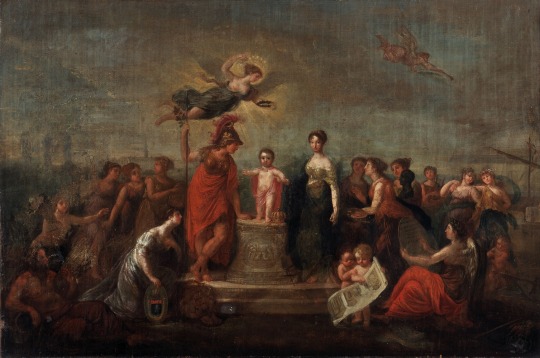

Allegory of the Birth of the King of Rome, 1811
Ernest Joseph Bailly
Museum of Fine Arts Ghent
#Ernest Joseph Bailly#Bailly#Napoleon ii#Duke of Reichstadt#king of Rome#Museum of Fine Arts Ghent#Flemish institute of archives#napoleonic era#napoleonic#napoleon#napoleon bonaparte#first french empire#french empire#history#19th century#painting#Flemish#Flemish art#baroque#Marie Louise of Austria#Marie Louise#Marie-Louise#neoclassical#art#paintings#19th century art
20 notes
·
View notes
Text
10 aprile … ricordiamo …
10 aprile … ricordiamo …
#semprevivineiricordi #nomidaricordare #personaggiimportanti #perfettamentechic
2024: Paola Gassman, è stata un’attrice teatrale italiana, figlia di Vittorio Gassman e Nora Ricci e sorellastra della dott.ssa Vittoria, dell’attore Alessandro e del regista Jacopo. Paola si dedicò quasi esclusivamente al teatro, a eccezione di alcune sporadiche ma significative apparizioni televisive in commedie e sceneggiati. Negli ultimi anni con l’attore Ugo Pagliai, conosciuto ai tempi…

View On WordPress
#10 aprile#Carlo Sabatini#Curt Conway#Curtis Conway#Dixie Carter#Dixie Virginia Carter#Giuseppe van Lamsweerde#Henry de La Falaise#James Henry Le Bailly de La Falaise#Jean Trent#Joseph van Lamsweerde#Kay Medford#Kevin Peter Hall#Kurt Conway#Linda Darnell#Manó Kertész Kaminer#marchese de La Coudraye#Margaret Kathleen O&039;Reagan#Maria Pia Casilio#Michael Curtiz#Miska#Monetta Eloyse Darnell#Nora Barnacle#Nora Eddington#Opal Jones#Pino Van Lamsweerde
0 notes
Text




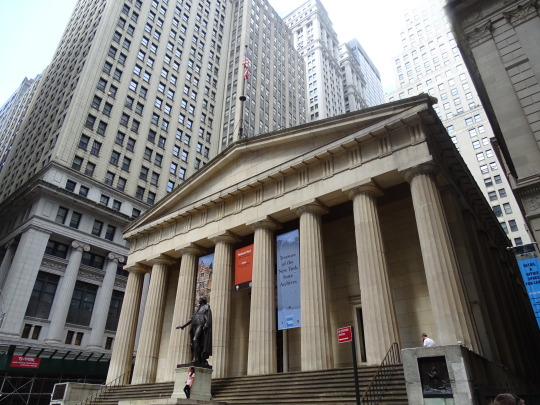




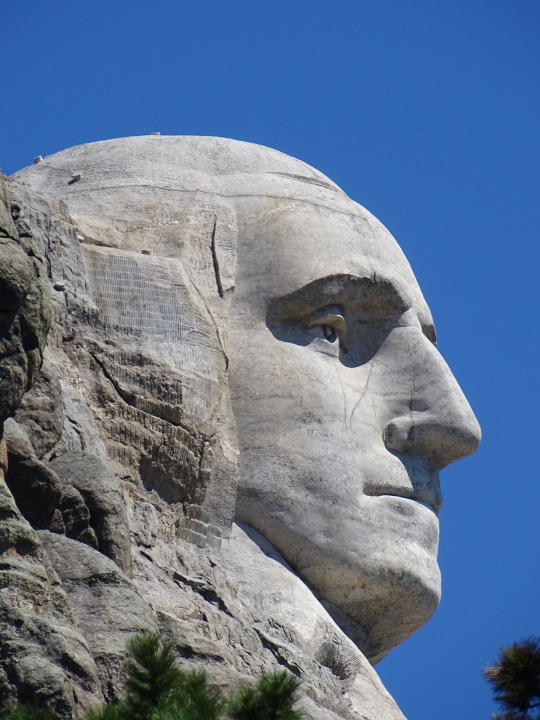




George Washington delivered the first State of the Union address in New York City on January 8, 1790.
#George Washington by Joseph A. Bailly#George Washington#first State of the Union address#8 January 1790#USA#Mount Rushmore National Memorial#Gutzon Borglum#South Dakota#2019#anniversary#US history#original photography#Lower Manhattan#vacation#New York City#Federal Hall National Memorial#John Quincy Adams Ward#Henry Kirke Brown#26 Wall Street#Financial District#Greek Revival–style#Town and Davis#tourist attraction#landmark#architecture#cityscape#travel
0 notes
Text
Direzioni
Dopo oltre 100 anni, Luigi XVI Re di Francia, per cercare di contenere il malcontento della popolazione, convoca gli Stati Generali. Istituito da Filippo Il Bello il 10 aprile 1302 nella chiesa di Notre-Dame a Parigi, dal 1400 si riuniva periodicamente, attraverso la convocazione dei Rappresentati dei Tre ordini Sociali, Nobiltà, Clero e Terzo Stato, secondo un particolare meccanismo: le elezioni dei rappresentanti procedevano attraverso una prima designazione di elettori locali (mediante gli Stati provinciali), i quali si riunivano nel capoluogo, elaboravano i cahiers de doléances (quaderni nei quali erano raccolte, per ciascun ordine, le lamentele e i voti da presentare al sovrano) ed eleggevano i deputati all’assemblea generale. Durante la convocazione, i 3 ordini si riunivano separatamente per redigere un cahier unico basato su quelli provinciali e un solo deputato per ogni stato parlava nell’assemblea generale e nell’ordine: clero, nobiltà e terzo stato. Gli Stati generali poi si scioglievano senza attendere la risposta del governo del re.
Il Terzo Stato, ormai maggioranza di fatto politica in Francia, voleva spezzare l’abituale legame tra Nobiltà e Clero, pertanto esce dagli Stati Generali e il 17 giugno forma l’Assemblea nazionale. Il Re in un primo momento cerca in tutti i modi di fermare l’operazione, tanto che il 20 giugno l’abituale sala dell'Hôtel des Menus-Plaisirs a Versailles è interdetta per “lavori di manutenzione”. Su proposta del deputato Joseph-Ignace Guillotin (si, l’uomo da cui prende il nome la ghigliottina, pensata come strumento per non far soffrire i condannati a morte) tutti si spostarono in una vicina sala adibita al gioco della pallacorda, un antenato del tennis; mentre il presidente dell'assemblea, l'astronomo Jean Sylvain Bailly si preoccupò di avvisare i colleghi di spostarsi. Una volta entrati, qualcuno offrì una sedia a Bailly il quale, invece di accettarla, si pose sopra ad un tavolo, rifiutando di sedersi mentre l'Assemblea si stava riunendo. Fu Bailly, da presidente dell'Assemblea, a proporre il famoso giuramento, ricordato come Giuramento della pallacorda - scritto da Jean-Baptiste-Pierre Bevière - e fu anche lui il primo a pronunciarlo e a sottoscriverlo. Tutti lo imitarono, firmando il documento, e giurando solennemente «di non separarsi mai e di riunirsi ovunque le circostanze l'avrebbero richiesto, fino a che non fosse stata stabilita e affermata su solide fondamenta una Costituzione per il regno francese». Ci fu un'unica eccezione, Joseph Martin-Dauch, deputato di Castelnaudary, che non giurò e si oppose apponendo la scritta "avversario" accanto alla sua firma. Bailly tentò di ottenere da Martin-Dauch una ritrattazione, ma senza successo.
Sin dalle prime riunioni, infatti, si schieravano alla destra del Presidente Bailly i membri dell’Assemblea con posizioni più moderate, più inclini al compromesso e alla trasformazione graduale del vecchio ordine. Nella parte sinistra, invece, sedevano i membri più rivoluzionari. Al centro quelli con posizioni intermedie. Fuori dall’assemblea, nascevano anche club privati in cui le idee dei vari gruppi politici venivano discusse e propagandate. Ne nasceranno moltissimi, ma all’inizio i più importanti sono i foglianti (di destra) e i giacobini (di sinistra): i foglianti prendono nome dall’ordine religioso fondato da Jean de la Barrière (Saint-Céré 1544 - Roma 1600), abate di Feuillant presso Tolosa, che avevano un monastero a Parigi; i giacobini prendono il loro nome per la stessa maniera, dato che il loro club aveva sede nell’ex convento parigino dei domenicani (Jacobins) nella via Saint-Honoré. Sorto nel maggio 1789 come Club breton, divenuto poi Société des amis de la constitution, nacque di indirizzo prevalentemente monarchico-costituzionale fino alla metà del 1790, orientandosi poi rapidamente verso concezioni di repubblicanesimo intransigente.
I primi provvedimenti sono di portata epocale: il 4 agosto vengono aboliti i privilegi feudali, il 26 dello stesso mese viene approvata la Dichiarazione dei diritti dell’uomo e del cittadino. Il re tenta di opporsi anche con l’uso dell’esercito, ma il 5 ottobre una folla di donne partita da Parigi (a cui si uniscono 20.000 guardie cittadine, compreso il loro capo Lafayette), arriva fino alla sua residenza di Versailles, e lo convince ad approvare i provvedimenti dell’Assemblea. È l’inizio della rivoluzione.
POST GENTILMENTE SCRITTO PER IL MINISTRO DELLA CULTURA CHE IERI HA DEFINITO DANTE ALIGHIERI UOMO DI DESTRA. GRAZIE
15 notes
·
View notes
Text




The Scottish Sculptor Alexander Milne Calder was born on August 23rd 1846
Alexander Milne Calder was born in Aberdeen, Scotland, the son of a tombstone carver. He began his career in Scotland, working for sculptor John Rhind, the father of sculptor J. Massey Rhind while attending the Royal Academy in Edinburgh. He moved to London and worked on the Albert Memorial. Calder immigrated to the United States in 1868 and settled in Philadelphia, where he studied with Joseph A. Bailly, and took classes (as would his son Alexander Stirling Calder) with Thomas Eakins at the Pennsylvania Academy of Fine Arts.
In 1873, he was hired by architect John McArthur, Jr. to produce models for the architectural sculpture of Philadelphia City Hall. The commission involved more than 250 pieces in marble and bronze, and took Calder 20 years to complete. That same year, he was commissioned by the Association for Public Art (then the Fairmount Park Art Association) to create an equestrian statue of Major General George Gordon Meade for Fairmount Park. In 1875 he won the competition for the colossal bronze statue of William Penn that was to crown its tower.
2 notes
·
View notes
Text
Gli altri sport: Mike Parkes

Un grande pilota, ma anche un ottimo progettista, nella Formula Uno degli anni Settanta…
Mike Parkes nacque il 24 settembre 1931 a Richmond, nel Surrey, da John Joseph Parkes e Mary Beatrice Johnson.
Il padre, ingegnere con il brevetto di pilota di aereo nel ramo ausiliario della RAF, durante la Seconda Guerra Mondiale diresse due fabbriche della De Havilland, nel dopoguerra fu amministratore delegato, e successivamente presidente, di Alvis Ltd.
Dopo aver studiato alle Lockers Park Preparatory School e Haileybury College nel 1950 Mike divenne studente-apprendista alla Humber-Hillman e dal 1952 fu 1962 ingegnere nel Reparto Sperimentale della Rootes Group.
Mike nel 1952 vinse la prima gara automobilistica al volante della sua MG TD e nella stagione 1954-55 gareggiò con delle Frazer-Nash d’epoca.
Dal 1955 al 1962 lavorò alla progettazione e sviluppo della Hillman Imp, che entrò in produzione nel 1963.
Nel 1957 Mike gareggiò con la Ford Lotus Eleven di Geoff Williamson e nella stagione 1958-59 con la Fry Climax F2 di David Fry.
Con la Lotus Elite di Sir Gawaine Baillie nel 1960 Parkes si cimentò nelle prime gare di lunga distanza a Le Mans e al Nürburgring.
La stagione 1961-62 lo vide al volante delle berline Jaguar 3.8 e le Ferrari 250GT per le scuderie Equipe Endeavour e Maranello Concessionaires, e con la Gemini Ford Formula Junior della scuderia Chequered Flag.
Ma il debutto di Mike con la Ferrari avvenne nel 1961 a Le Mans, con co-pilota Willy Mairesse, si finì al secondo posto.
Parkes nel 1963 si trasferì a Modena e fu assunto dalla Ferrari come ingegnere allo sviluppo e pilota ufficiale per le gare sport e prototipi, oltre ad essere il pilota ufficiale nelle gare di lunga distanza per auto sport e prototipi, in Europa e negli Stati Uniti, ottenendo molti piazzamenti.
Dopo che nella stagione 1966-1967 ebbe due primi posti, due secondi posti e un quinto posto, Mike nel giugno 1967 fu vittima di un grave incidente al GP del Belgio, in cui si ruppe le gambe e il polso.
Nel 1969 ritornò alla Ferrari come ingegnere allo sviluppo e direttore di squadra per le gare sport e prototipi, poi Enzo Ferrari gli propose di lavorare per Georges Filipinetti, il concessionario svizzero della Ferrari, che nella stagione 1970 avrebbe partecipato alle gare con un Prototipo 512 simile a quelli della fabbrica.
Fino al 1973 Parkes fu il direttore sportivo e pilota per la Scuderia Filipinetti e dal 1974 al 1977 lavorò come Ingegnere allo sviluppo per la squadra Rally della Lancia.
Il 28 agosto 1977, dopo un soggiorno a Modena, Mike stava tornando a Torino una domenica sera per rientrare al lavoro e vicino a Riva di Chieri, non molto lontano da Torino, entrò in una curva stretta ad angolo retto alla fine di un rettilineo lungo quattro chilometri.
La macchina di Parkers, una Lancia Beta HPE slittò verso il lato sinistro della strada, e si scontrò frontalmente con un camion che arrivava dall’altra parte e Mike morì all’istante, per una frattura alla spina dorsale.
Parkes è sepolto in Inghilterra, nel cimitero del paesino di Charsfield, dove abitava suo padre.
Read the full article
4 notes
·
View notes
Photo


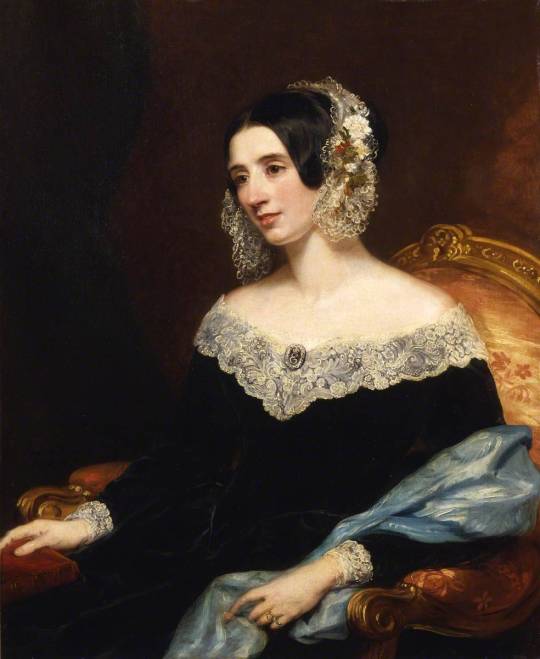

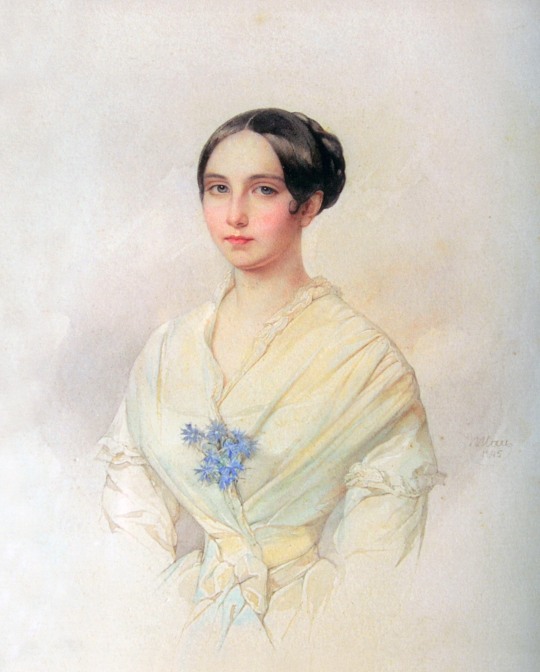





On to 1845 -
Top: 1845 Vicomtesse Othenin d'Haussonville, née Louise-Albertine de Broglie by Jean Auguste Dominique Ingres (Frick Collection - New York City, New York, USA). From Wikimedia 4639X6500 @72 7Mj.
Second row left: 1845 Ekaterini Botzaris Caradja painted by Pietro Luchini (location ?). From Wikimedia; expanded to fit screen 1078XZ1400 @72 495kj.
Second row right: 1845 Henrietta Baillie (d.1856) by Margaret Sarah Carpenter (Royal College of Physicians - London, UK). From centuriespast.tumblr.com/post/178198887928/henrietta-baillie-d1856-margaret-sarah 984X1200 @72 188kj.
Third row: 1845 Prinzessin Auguste Ferdinande von Bayern, Erzherzogin von Österreich-Toskana by Joseph Karl Stieler (auctioned by Neumeister). From their Web site. removed spots & fixed one flaw with Photoshop 2782X3307 @300 1.1Mj.
Fourth row left: 1845 Emilia Karlovna Musina-Pushkina by Vladimir Ivanovich Hau (location ?) 3304X4112 @600 3.3Mj.
Fourth row right: 1845 Anna von Minarelli-Fitzgerald by Anton Einsle (National Gallery of Ireland - Dublin, Ireland). From their Web site; fixed obvious spots & flaws w Pshop 1987X2480 @300 2Mj.
Fifth row: 1845 Queen Marie-Amelie with the duc de Nemours' two sons by Franz Xaver Winterhalter (location ?). From the lost gallery's photostream on flickr 1346X2000 @180 872kj.
Sixth row left: 1845 Louise von Wertheimstein (Vienna 1813-1890), born Biedermann by Anton Einsle (location ?). From pinterest.se/bjornolofkihlbe/art-austrian-artists/anton-einsle/ 3445X4512@300 3.7Mj.
Sixth row right: ca. 1845-1850 Baronne X. Amazone en chapeau by Alfred de Dreux (Jean-François Heim - Basel, Basel-Stadt, Switzerland). From their Web site 1866X2493 @72 1.4Mj.
Bottom: 1844-1845 E. I. Ton by Alexey Vasilievich Tyranov (location ?). From deligent.livejournal.com/22455885.html; fixed cracks w Pshop 1000X1242 @120 339kj.
6 notes
·
View notes
Text
MALICIOUS (2023) Review of home invasion thriller
‘The truth might set you free’
Malicious is a 2023 American thriller film about a family weekend getaway that turns nasty when a mysterious stranger knocks on their door.
Directed and co-produced by John Fallon (The Shelter; short: The Red Hours) from a screenplay co-written with co-producer and co-star Kevin Interdonato. Also produced by Nick Baillie and Joseph Sernio. Executive produced by…

View On WordPress
#John Fallon#Kevin Interdonato#Malicious#Melissa Anschutz#movie film#Nick Baillie#review reviews#trailer
0 notes
Text
Uno degli ultimi ritratti della contessa Du Barry, di Elizabeth Louise Vigée Lebrun. Il dipinto fu iniziato nel 1789 e terminato postumo, nel 1805.
L'8 dicembre 1793, fu giustiziata Madame Du Barry.
Dalle Memorie del boia Charles-Henri Sanson, veniamo a conoscenza degli ultimi suoi momenti di vita.
****
17 Frimaio.
La signora Dubarry è stata condannata ieri sera e giustiziata questa mattina.
Eravamo, secondo l'ordine, alle nove nel carcere, ma dovevamo aspettare perché la condannata era rinchiusa con il cittadino Denizot, giudice, e il cittadino Royer, vice dell'accusatore, che hanno registrato le ultime confessioni. .
Alle dieci furono introdotti i cittadini Vandenyver: il padre ei due figli, tutti complici di Madame Dubarry, ei cittadini Bonnardot e Joseph Bruniot, falsificatori di assegnatari, condannati dal tribunale penale.
Mentre ci stavamo organizzando, Madame Dubarry è arrivata. Camminava, appoggiata alle pareti, perché le sue gambe si stavano flettendo sotto di lei. Erano passati vent'anni dall'ultima volta che l'avevo vista e non l'avrei riconosciuta; era sfigurata dalla carnosità come dal dolore e dall'angoscia. Quando mi ha visto dietro i condannati già legati, ha lanciato un grande "Ah!" nascondendo gli occhi sotto il fazzoletto e si è inginocchiata gridando "non voglio, non voglio".
Quasi subito si è alzata e ha detto "Dove sono i giudici, non ho dichiarato tutto, non ho confessato tutto!". I cittadini Denizot e Royer erano da Richard, con due o tre controllori, che erano stati curiosi di vedere passare la povera donna; sono arrivati quasi subito, ma si sono rifiutati di entrare in anagrafe e le hanno ordinato di parlare subito. Dichiarò poi alcuni oggetti preziosi che erano nascosti nella sua casa a Louvecienne o affidati a vari privati, ma si fermò in ogni momento a lamentarsi e, in varie occasioni, percorse la campagna come se la sua mente fosse stata sviata dalla febbre.
Il cittadino Royer, che aveva in mano la penna, gli disse "È tutto?" E lui stava cercando di convincerla a firmare il verbale ma lei spinse via il foglio, si assicurò di avere qualcosa da aggiungere; si vedeva che stava cercando nella sua memoria.
Forse credeva che a causa delle immense somme che rinunciava, le sarebbe stato concesso il perdono e mai, nei suoi giorni felici, aveva desiderato così ardentemente ricchezze che ora, che le stava sacrificando per risparmiare qualche minuto sulla morte.
Alla fine, i cittadini Denizot e Royer si alzarono e gli dissero molto duramente che doveva sottomettersi ai decreti di giustizia e riscattare con il suo coraggio l'ignominia della sua vita passata.
Rimase come distrutta sulla sedia.
Un aiutante si avvicinò e pensò che fosse un buon momento per tagliarle i capelli, ma al primo taglio delle forbici si alzò e lo spinse via, e altri due aiutanti dovettero aiutarla a legarla.
Così ha lasciato andare, solo che ha pianto come non ho mai visto piangere.
C'era tanta gente sulla banchina quanto all'uscita della Regina (due mesi prima) e dei deputati dalla Gironda. Gridavano con decisione, ma le grida della vittima erano ancora più alte di quelle della gente. Non abbiamo camminato per cento passi finché non l'abbiamo sentita. Ha detto "Buoni cittadini, liberatemi, sono innocente. Io sono una persona come voi, buoni cittadini, non lasciatemi morire!!".
Non ci siamo mossi, ma i cittadini chinavano il capo e non le lanciavano più insulti.
Non riconoscevo più le persone della ghigliottina, eppure erano davvero le stesse persone che avevo visto per il cittadino Bailly.
A volte smetteva di gridare; dal viola che era il suo viso, la si poteva vedere diventare completamente bianca. Si abbandonò ai sobbalzi del carro come se fosse morta; barcollava qua e là; dieci volte sarebbe caduta se mio figlio non l'avesse sostenuta.
A volte si rivolgeva a me dicendomi: "No, giusto, non mi ucciderai?" Batteva i denti e la voce usciva dalla sua gola, rauca e agitata. Io mi sentivo addolcito come gli altri e più amaramente di chiunque altro, perché la vista di questa donna infelice mi ha ricordato la nostra giovinezza, che a malapena prediceva un simile destino, e il suo degno padre, la cui sollecitudine non poteva per toglierle né una grandezza così fatale né una caduta così terribile.
Nonostante tutti i miei sforzi per superare la mia emozione, il viaggio non era mai durato così a lungo. Una volta le ho consigliato di pregare, questo l'avrebbe sicuramente confortata. Le preghiere non le tornavano più e lei diceva "Mio Dio mio Dio mio Dio" senza trovare altro.
L'ordine era che sarebbe stata giustiziata per ultima, ma quando sono andato al piano di sotto, l'ufficiale giudiziario mi ha detto di organizzare per il meglio.
Come vedendo la ghigliottina che aveva ceduto, ho detto di montarla subito; ma non appena lei sentì le mani addosso, riprese conoscenza e, sebbene legata, spinse indietro gli assistenti gridando "Non subito; ancora un momento, signori carnefici, un altro momento, per favore." .
L'hanno trascinata via, ma lei ha lottato e ha cercato di morderli.
Era tanto forte quanto potente, perché sebbene fossero in quattro, passarono più di tre minuti a montarla. Se non li avesse scaldati spingendoli in giro, non so se li avrebbero superati, erano così sgomenti. Allo stesso modo, nessuno mormorò una parola e molti fuggirono da ogni parte come in rotta. Lassù è ricominciato, stava urlando; si poteva sentire da oltre il fiume, era molto spaventoso da guardare; alla fine sono riusciti a chiuderla, ed è stato fatto.
Poi abbiamo giustiziato gli altri.
18 Frimaio.
Oggi abbiamo ghigliottinato Jean-Baptiste Noël, deputato dei Vosgi, fuorilegge.
Lungo la strada, mi ha chiesto se era vero che Madame Dubarry aveva avuto tanta paura; e, un'altra volta, se avessimo pulito bene la lama, perché non era giusto che il sangue di un repubblicano venisse imbrattato dal sangue di una prostituta.

1 note
·
View note
Text
"An officer of the Revolution": The story of Mountjoy Bayly [Part 1]

The Mountjoy Bayly House (also known as the Bayly House, Hiram W. Johnson House, Chaplains Memorial Building, Parkington, and Mott House) located at 122 Maryland Avenue, NE in the Capitol Hill neighborhood of Washington, D.C. Photograph courtesy of Wikimiedia. Mr. Bayly lived in this house while working as a doorkeeper and sergeant-at-arms in the US Senate, building it not before 1812, but sometime between 1817 and 1822. Currently, this is the headquarters of the Fund for Constitutional Government and the Stewart R. Mott Foundation. Previously it was the headquarters of the American Civil Liberties Union (ACLU)
This post continues the series on Maryland's Extra Regiment, focusing on the postwar lives of certain members of the unit whom information is plentiful about to explain wide-ranging trends. Mountjoy/Montjoy Bayly, whose last name can be spelled Bayley, Baley, Bailey, and Baillie, was not like unit commander Alexander Lawson Smith, who settled in Harford County until his death in 1802. Likely of Scottish origin, Mountjoy immigrated from Virginia, living in Frederick Town, within Frederick County. [1]
Reprinted from my History Hermann WordPress blog.
By the end of the war, in 1783, he had, for the time being, ended his varied military career. He served as an adjutant, and later a captain, in the 7th Maryland Regiment, from December 1776 to September 1778, when he resigned, sending George Washington a letter acknowledging this reality. [2] Within his duties as a captain, he fought at the Battle of Brandywine. On the day of the battle, on September 11, 1777, he led a patrol of Maryland soldiers wearing red coats, with a Quaker and "well-to-do farmer," named Joel Baily, thinking that they were the British and welcomed them heartily as a result. [3] However, Mountjoy soon would be out of commission for many years.
Within the sweltering weather and rough battle of Monmouth, in New Jersey, on June 18, 1778, he "broke a blood vessel" which rendered him "unfit for duty." He remained unable to "do duty until the Spring of 1780," sitting in a Pennsylvania hospital, as he said years later in his federal veterans pension application. [4] While he sat in the hospital, in an "unfortunate disposition," his regiment was ordered south, as he recalls. Even though he was later considered an "invalid," meaning that he had been injured in battle, he was still chosen as a captain in the Extra Regiment, which barely had a mention in his pension, only referenced in passing as the "additional regiment" of the Maryland Line. In later years, after serving in the Extra Regiment, he served as a recruiting officer in Frederick County and as "local city major and commandant of prisoners" in the town of Frederick as captured Hessian private Johann Conrad Döhla described him. [5] He placed people under arrest and oversaw Hessian prisoners, from 1781 to the end of the war. He even held a court-martial, in December 1781, in the town of Frederick since the officers commanding the militia in the county did not have, in his words, "the least Idea of discipline or indeed even distinction."
Mountjoy's life after the war

Fairfax County, Virginia (and surrounding counties) as pictured in Thomas Jeffery's 1755 map. Courtesy of the Library of Congress.
One year before the conclusion of the war, his father, William, died. However, Mountjoy still had many siblings and his mother, Mary, surviving him. He had six brothers (Pierce, William, Samuel, Joseph, Tarpley, and Robert), and three sisters (Sarah, Nancy, and Betty). [6] As a result of his father's death he may have inherited his father's land in Virginia, which likely included hundreds upon hundreds of acres. This is buttressed by the fact that Mountjoy was buying deeds to property in Fairfax County, Virginia in 1783 and 1784, along with part of a land agreement in 1782 with his father before his death. While Edward Papenfuse says he was entitled to 200 acres in Allegheny County for his service during the Revolutionary War, no record of his land plot in that county can currently be found. [7] However, Papenfuse may have a valid point in saying that he expanded his land holdings in Frederick County, including 47 acres of confiscated British property, and selling 192 acres between 1785 and 1805.
In 1784, Mountjoy cemented his ties with the Edelin/Edelen (Edelin is used in this article) family, prominent and wealthy within Frederick County, especially manifested in Christopher Edelin, a merchant who had become part of the local government in the county during the Revolutionary War. [8] As it turned out, Mountjoy married Elizabeth Edelin, the daughter of Christopher, with the connections between the two families continuing for years to come. He would have four children with Elizabeth, called by her first name in the rest of this article, named Benjamin, Richard, Eleanor, and Elizabeth. [9] Two land transactions the same year seems to indicate when Mountjoy was married. In September 1784, he paid a Baltimore merchant, Hugh Young, to buy a 450-acre tract known as "Victory" and later sold that same tract to Joseph Smith, who might be the son of the person it was originally surveyed for in 1773: Leonard Smith, when the tract consisted of 468 acres. [10] Since Elizabeth is not included on the first transaction, but is included on the second, this indicates she was possibly married to Mountjoy sometime between September 4 and 25.
Later in the 1780s, as Mountjoy continued to buy and sell land, Elizabeth would become more involved in these transactions, especially when it came to selling land. In December 1785, he bought the land on which his father-in-law, Christpher, previously mentioned, lived, which included a stone house and sat on a street in Frederick Town (present-day Frederick). [11] Not long after, he began his slave ownership, as much as we know. He bought an 19-year-old enslaved Black woman named "Pack" and an unnamed two-year-old enslaved Black female from Christopher. [12] These transactions were not surprising since Christopher would die the following year, 1786.
It would not be until 1787 that Elizabeth would agree with one of her husband's sales. He would sell land to numerous individuals, such as Joseph Young and George Scott, while buying land from Benjamin Dulany, mortgaging land to George Schuertzell and Peter Mantz, a former major of the Maryland Flying Camp, as the Bayly family lived comfortably in Frederick Town. [13] This included one piece of land called Salsbury/Salisbury Plains which was originally surveyed for Christopher in 1774, and consisted of 131 acres. By 1789, there was another change: Mountjoy re-entered the US military in 1789 as a major, the first of his forays back into the armed services. [14]
Mountjoy, the Maryland House of Delegates, the "Whiskey Rebellion," and French prisoners
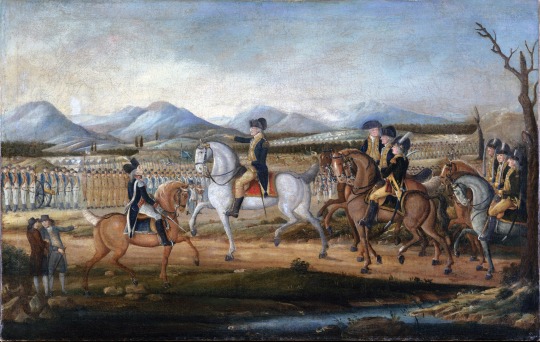
A 1795 painting reportedly by Frederick Kemmelmeyer titled "The Whiskey Rebellion" which depicts George Washington and his troops near Fort Cumberland, MD before they suppress the revolting farmers in western Pennsylvania. Image is courtesy of Wikimedia.
As a story goes, on June 13, 1791, George Washington ascended a hill in Frederick County and looked over the "beautiful Monocacy Valley." On that day, he was met by a "Cavalcade of Horsemen from Frederick" which included Mountjoy, and Colonel John McPherson, among others. [15] By this point, he had the political bug. While he had served as an auctioneer years earlier in Frederick County, it would not be until the mid-1780s and early 1790s he would serve as a delegate for Frederick County within the Maryland House of Delegates. [16] While serving as a legislator, he voted against creating a college on Maryland's Western shore, supported the prohibition of taxes to help "ministers of the gospel of any denomination," and helped prepare and bring in reports on inhabitants of Frederick Town and County. One year after his last legislative term, he rejoined the military as a brigadier general, serving in part of the Maryland Militia's Ninth Brigade, based in the upper part of Frederick County. [17]
While Mountjoy only served in the armed forces, for the fourth time, from 1794 to 1795, he was involved in a strong assertion of federal power. From 1791 to 1794, angry farmers, which some call "protesters," who declared themselves “Whiskey Boys,” attacked tax collectors in Pennsylvania, Georgia, Maryland, Virginia, North Carolina, and South Carolina. They did so because of the whiskey tax introduced by Secretary of Treasury Alexander Hamilton, calling, in part, for a more progressive tax code that didn't benefit the well-to-do. [18] Thomas Sim Lee, then the Governor of Maryland, organized state militia and "took an active part in the suppression of the Whisky Insurrection in western Pennsylvania and Maryland." Governor Lee ordered Mountjoy to rally local militia in the area, arm them, place a guard at the arsenal, and instruct another Maryland general, Smith, to raise a force of 800 men to "restore order." [19] By September 21, the rebelling farmers were dispersed, with most of them rounded up and turned over to the civil court system, as Governor Lee triumphantly told Hamilton. Mountjoy also met with Colonel Thomas Sprigg about guarding the "the magazine at Frederick." He wrote two letters about this. The first to Governor Lee, on September 10, with part of this letter describing the political environment in Western Maryland, specifically Washington and Allegheny counties where a "Spirit of disorder" existed, with "actual riots and disturbances":
I have thought it necessary to Send with the Arms &c Ordered to Allegany County a Strong Escort Consisting of one Complete Company. This I conceive will not be thought over cautious when your Excellency takes into View the existing Circumstances, these Arms &c will have to pass through Washington County Where the people are generally unfriendly to the present Views of the Government. Under this Idea of things I conceive it would be imprudent to risque the Supplies which you have Ordered.
Nine days later, Mountjoy wrote him another letter, in which he expanded on what he had said before:
In obedience to those orders, honoring me with the direction of the troops which your Excellency had commanded to rendezvouz at Frederick Town for the purpose of repressing that turbulent spirit which had violated peace & order and seemed to threaten Government itself in the Counties of Frederick Washington and Allegany...For that purpose I marched about 300 Infantry together with 70 horse through Harmans Gap which opens into the County of Washington near the Pennsylvania line, a rout which led me through the midst of those people whose turbulency it was your object to punish and repress. This was done with an intention to apprehend the characters who had been most active in their opposition to Governmt and whose names had been previously furnished to me for that purpose. It was supposed too that the appearance of an Armiment would have a very good effect, and convince those who had lost sight of their duty that Government could send forward a force at any time when necessity required it sufficient to inforce obedience to the Laws. On my arrival into Washington [County] I proceeded to carry into effect my arrangements by despatching the cavalry in quest of the Ringleaders. But upon the first display of the Horse, I found a party from Hagarstown [Hagerstown] had superceded the necessity of any exertion on my part, by having previously brought in those disorderly people to Justice. About the number of twenty [disorderly individuals] have been apprehended, all of which have been admitted to Bail except eight, these have not yet undergone their examination but most of them perhaps all of them will be committed to close Jail, without bail, however this is but opinion. Martin Bear and John Thompson had been examined before my arrival, and although both of them had been considered as notorious offenders they were admitted to Bail and to my great surprize Cols. [Thomas] Sprigg & [Rezin] Davis were their Securities. It is however but proper to add that upon the examination of these two men their was no evidence of their guilt save the general report as I am informed by those who were present [20]
Five years later, in September 1799, a captain in the First Regiment of Artillerists and Engineers, named Staats Morris (not the same as the British general of the same name) wrote to Hamilton about fifty French prisoners held by Mountjoy in Frederick Town. He says that
I have the honor to inform you that Lieut. Dyson returned from Frederick Town last night, having delivered the French prisoners (fifty in number) to Genl. Baily, as will appear by the enclosed receipt. By his report Lieut Newnan’s command is thought necessary as a guard over them. There have been several new cases of the fever at the fort since the date of my last letter; but from the report of the Surgeon and from the change in the weather, I am led to hope none will prove fatal. In my last letter I had the painful task of communicating to you the death of my young Kinsman, Lieut Lawrence Your letter received since containing orders for him (which I took the liberty of opening) has therefore been destroyed...[bottom:] enclosing Mountjoy Bayly’s receipt for fifty French prisoners
The same year, Mountjoy, a literate Presbyterian, planter, and "gentleman," would become a charter member of the Society of Cincinnati, a group of former revolutionary war officers. [21] Specifically, he would be one of the original members of the Society's branch in Maryland.
© 2016-2023 Burkely Hermann. All rights reserved.
#american revolution#revolutionary war#maryland#us history#battle of brandywine#1780s#hessians#extra regiment#regiment extra#maryland house of delegates#whiskey rebellion#1790s#society of cincinnati
0 notes
Text
10 aprile … ricordiamo …
10 … ricordiamo …
#semprevivineiricordi #nomidaricordare #personaggiimportanti #perfettamentechic
2020: Pino Van Lamsweerde, all’anagrafe Giuseppe van Lamsweerde, è stato un regista e animatore italiano naturalizzato canadese. (n. 1940)
2020: Carlo Sabatini, attore e doppiatore italiano. Noto per aver prestato voce a Ian McKellen/Magneto, ad Harvey Keitel, a Bruce Lee, a Morgan Freeman, e a tanti altri attori famosi. (n. 1932)
2012: Maria Pia Casilio, attrice italiana. (n. 1935)
2010:…
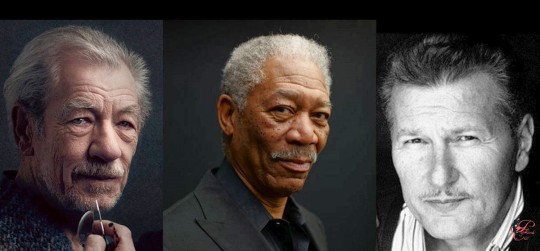
View On WordPress
#10 aprile#Carlo Sabatini#Curt Conway#Curtis Conway#Dixie Carter#Dixie Virginia Carter#Giuseppe van Lamsweerde#Henry de La Falaise#James Henry Le Bailly de La Falaise#Jean Trent#Joseph van Lamsweerde#Kay Medford#Kurt Conway#Linda Darnell#Manó Kertész Kaminer#marchese de La Coudraye#Margaret Kathleen O&039;Reagan#Maria Pia Casilio#Michael Curtiz#Miska#Monetta Eloyse Darnell#Nora Barnacle#Nora Eddington#Opal Jones#Pino Van Lamsweerde
0 notes
Photo

A stuffed spaniel and other examples of taxidermy. "Contributions of Ornamental Taxidermy" Exhibition, United States National Museum. 1884.
Smithsonian
Enlarge to see the numbers of all the items in the photo:
1. "Coming to the Point" by William Temple Hornaday
2. "An Interrupted Dinner" by Frederic A. Lucas
3. Head of Caribou (presented by by Professor Henry A. Ward) by W.J. Critchley
4. Peacock Screen by Thomas W. Fraine
5. "Wounded Heron" by F.S. Webster
6. Dead Gull by Edwin A. Capen
7. Frightened Owl by John Wallace
8. Bald Eagle by John Wallace 9. Fox Squirrel by P.W. Aldrich
9. Fox Squirrel by P.W. Aldrich
10. Humming-Bird Group by Mr. and Mrs. George H. Hedley
11. Group of Gray Squirrels by Joseph Palmer
12. Group of Ducks by William Palmer
13. Grotesque Group of Frogs by J.F.D. Bailly
14. Frogs Skating by J.F.D. Bailly
15. Snowy Heron by Thomas Rowland
16. Portrait of Jules Verreaux by by J.F.D. Bailly
180 notes
·
View notes
Photo
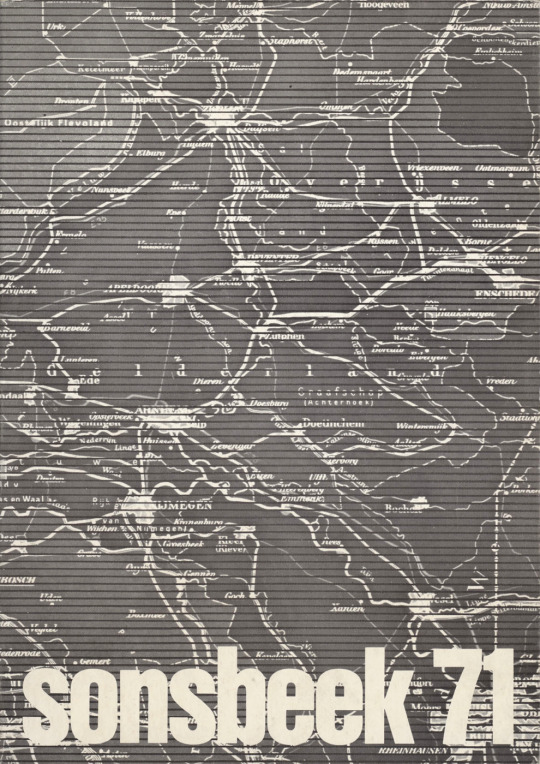
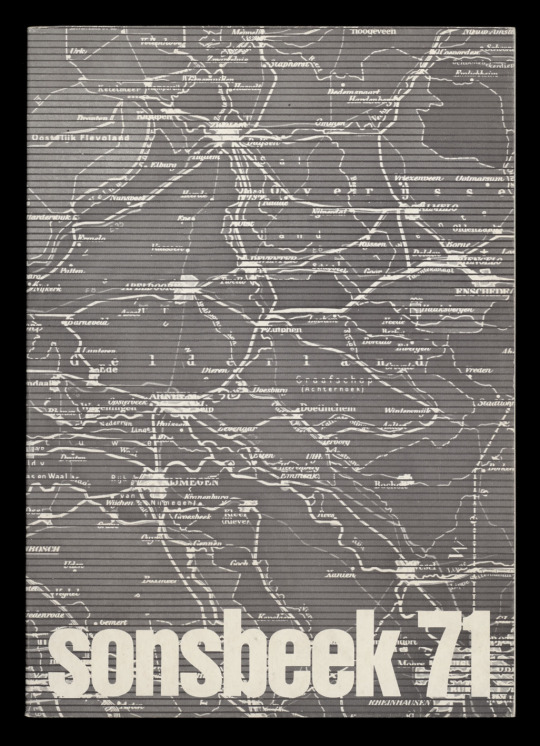
sonsbeek 71: sonsbeek buiten de perken, Deel 2, Curated by Wim Beeren, Park Sonsbeek, Arnhem, 1971. Graphic Design: Wim Crouwel, Dirk Fortuin, Magda Tsfaty, and Jolijn van de Wouw / Total Design
Feat. Vito Acconci, Bas Jan Ader, Carl Andre, Ben d'Armagnac, Richard Artschwager, Bruce Baillie, Douwe Jan Bakker, Joseph Beuys, Ronald Bladen, Marinus Boezem, Stanley Brouwn, Daniel Buren, Javacheff Christo, Tony Conrad, Hanne Darboven, Ad Dekkers, Ger Dekkers, Jan Dibbets, Ger van Elk, Pieter Engels, Groep Enschede, E.R.G., Hans Eijkelboom, Barry Flanagan, Fluxus, Hollis Frampton, Ernie Gehr, Dan Graham, Robert Grosvenor, Mike Heizer, Douglas Huebler, I.C.W., Ken Jacobs, joepat, Donald Judd, On Kawara, W. Knoebel, Hans Koetsier, Axel van der Kraan, Peter Kubelka, George Landow, Standish Dyer Lawder, Sol Lewitt, Richard Long, Walter de Maria, Mass Moving, Yutaka Matsuzawa, Mario Merz, Henri Moore, Robert Morris, Bruce Nauman, Noord-Brabant Groep, Claes Oldenburg, Dennis Oppenheim, Nam June Paik, Panamarenko, Egbert Philips, Emilio Prini, Klaus Rinke, Peter Roehr, Ulrich Rückriem, Edward Ruscha, Fred Sandback, Jean-Michel Sanejouand, Wim T. Schippers, Paul Sharits, Eric Siegel, Tony Smith, Robert Smithson, Richard Serra, Kenneth Snelson, Michael Snow, Koert Stuyf and Ellen Edinoff, Shinkichi Tajiri, Sajiki and Yokoyama Tenjo, Carel Visser, Andre Volten, Hans de Vries, Lex Wechgelaar, Lawrence Weiner, Joyce Wieland
#graphic design#typography#art#map#exhibition#catalogue#catalog#cover#sonsbeek#wim beeren#park sonsbeek#wim crouwel#dirk fortuin#magda tsfaty#jolijn van de wouw#total design#collectie nago#1970s
60 notes
·
View notes
Photo










The Scottish Sculptor Alexander Milne Calder was born on August 23rd 1846.
Alexander Milne Calder was born in Aberdeen, Scotland, the son of a tombstone carver. He began his career in Scotland, working for sculptor John Rhind, the father of sculptor J. Massey Rhind while attending the Royal Academy in Edinburgh.
He moved to London and worked on the Albert Memorial. Calder immigrated to the United States in 1868 and settled in Philadelphia, where he studied with Joseph A. Bailly, and took classes (as would his son Alexander Stirling Calder) with Thomas Eakins at the Pennsylvania Academy of Fine Arts.
In 1873, he was hired by architect John MacArthur, Jr. to produce models for the architectural sculptures on Philadelphia City Hall. The commission involved more than 250 pieces in marble and bronze, and took Calder 20 years to complete. That same year, he was commissioned by the Association for Public Art (then the Fairmount Park Art Association) to create an equestrian statue of Major General George Gordon Meade for Fairmount Park, as seen in the last pic
In 1875 he won the competition for the colossal bronze statue of William Penn that was to crown its tower.
Pics are mainly from Philadelphia City Hall.
15 notes
·
View notes
Text
Frev Zodiacs
(because i’m bored and didn’t see anyone else do this)
(Also, please ignore the inconsistency with names & people. I also apologize for the Aries people out there. )
Aries
Bernard René Jourdan, marquis de Launay
Taurus
Jean Pierre André Amar
Lazare Carnot
Olypme de Gouges
Maximilien Robespierre
Emmanuel Joseph Sieyés
Gemini
Jacques-Nicolas Billaud-Varenne
Pierre Gaspard Chaumette
Jean-Marie Collot d’Herbois
Joseph Fouché
Jean-Paul Marat
Marquis de Sade
Cancer
Paul Barras
Joséphine Bonaparte
Leo
Madame du Barry
Napoleon Bonaparte
Charlotte Corday
Fabre d’Eglantine
Therogine de Mericourt
Virgo
Jean Sylvain Bailly
Jacques-Louis David
Marie-Jean Hérault de Séchelles
Marie Thérèse Louise of Savoy
Gilbert du Motier, Marquis de Lafayette
Antoine Lavoisier
Louis XVI
Louis Antoine de Saint-Just
Libra
Pierre Aurgeru
Jacques Necker
Scorpio
Jean Chouan
Georges Danton
Jacques René Hébert
Philippe Le Bas
Marie Antoinette
Sagittarius
Françoise-Nöel Babeuf
Antoine Barnave
Capricorn
Jacques Pierre Brissot
Georges Couthon
Lucile Desmoulins
Jérôme Pétion de Villenevue
Aquarius
Thomas Paine
Jean-Marie Roland
Jean-Lambert Tallien
Charles-Maurice de Talleyrand-Périgord
Pisces
Camille Desmoulins
Honoré Gabriel Riqueti, comte de Mirabeau
Madame Roland
30 notes
·
View notes
Text
Dhammapada 176
If a man has transgressed one law, and speaks lies, and scoffs at another world, there is no evil he will not do.
IMAGE: Ernest Joseph Bailly, The Contempt of Hate (1792)

2 notes
·
View notes